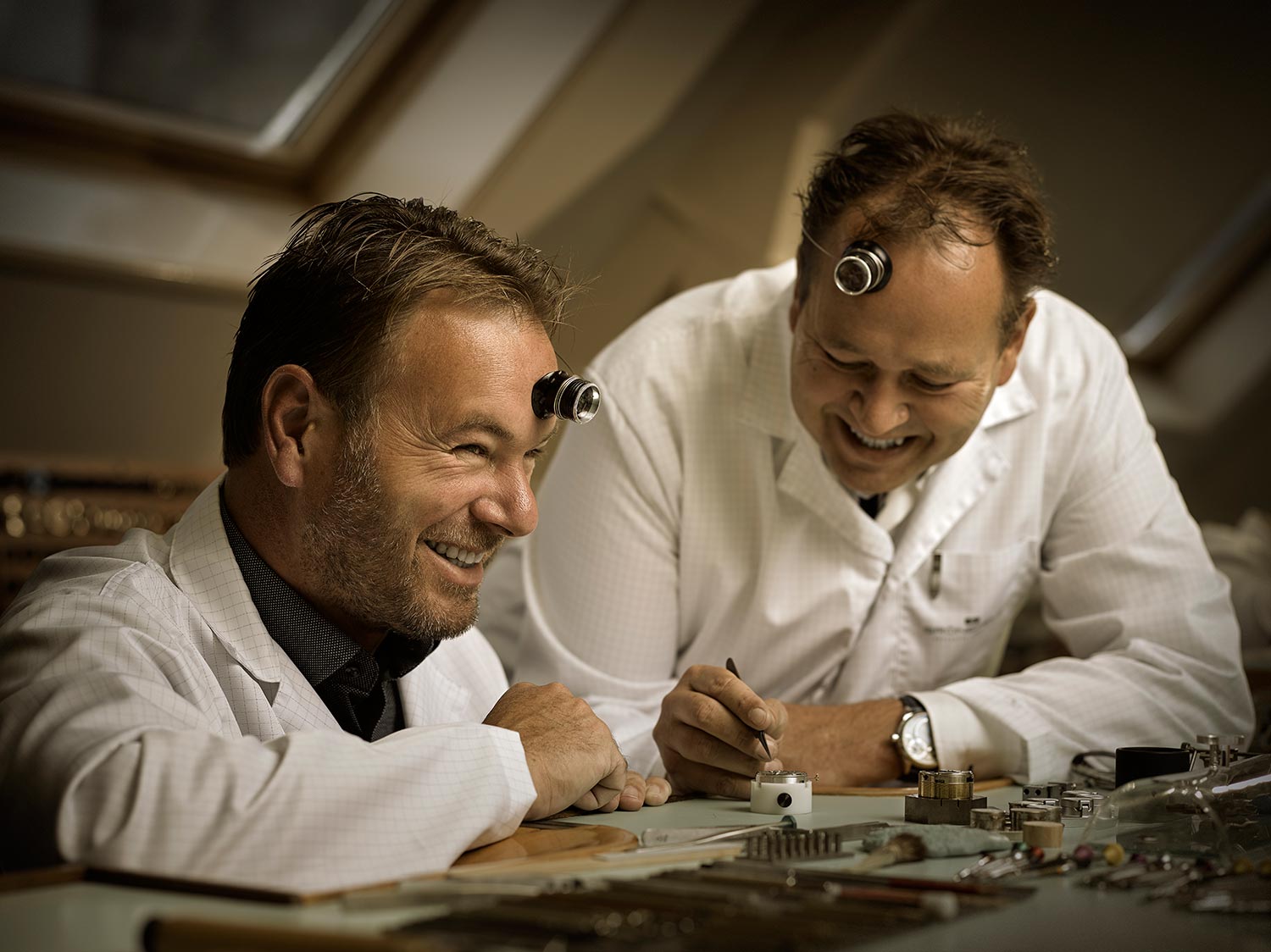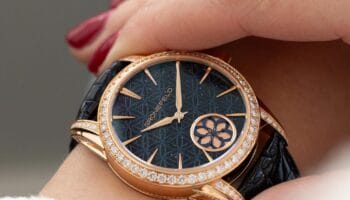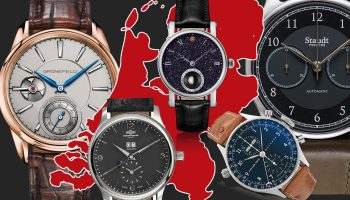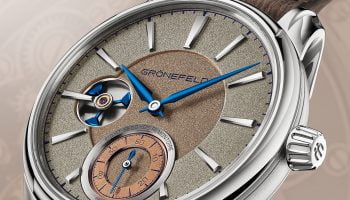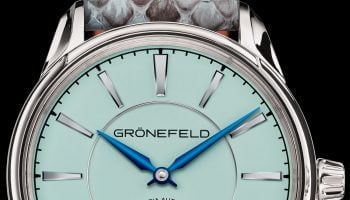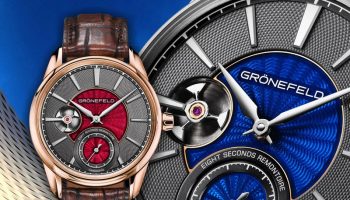Award winning Dutch brothers Grönefeld have some news for you. Bart and Tim present a collaboration with their friend Kari Voutilainen. There admiration for this Finnish watchmakers of bespoke engine turned dials lead to a solid friendship. This enigmatic threesome felt the urge again to collaborate in order to provide in the growing demand for personalised high-end, technical timepieces. A trending topic on the SIHH for sure.
Grönefeld dials are engine-turned sometimes referred to as guilloché dials. The proces confers each dial with its own unique appearance. The patterns are made, not by a computer-aided machine, but on a century old machine. Every decorative line is made at very low speed by deft hand and the skilful precision of a wel-trained eye. A big wauw factor – no doubt. You have to have a lot of patience and love to do this painstaiking effort to produce just one guilloché dial. The fantastic lush enamelling ads up to a profound dept hand lustre tot he guilloché patterns. Because enamel is glass, not paint, it does not fade under ultraviolet light and will keep its lustre for years, decades or even centuries to come. Specialist Inès Hamaguchi is responsible for the delicate enamelling of the Grönefeld dials.
Stainless steel case for the 1941 Remontoire
Besides the existing versions in 18-carat red and white gold, the 1941 Remontoire is now also offered in stainless steel. Bart and Tim believe the 1941 Remontoire looks spectacular in a stainless steel case owing to the combination of the case material and the distinctively arranged, hand decorated, stainless steel bridges. For this case, the 316L stainless steel alloy has been specially treated to obtain a very fine molecular structure. This treatment results in a brighter colour and glossier finish than a non-treated stainless steel alloy. A maximum of 25 Remontoire watches in a stainless steel case will be made. These will be offered with the existing collection of dials as well as the new, bespoke engine turned and enamel dials.
The remontoire explained
The name ‘remontoire’ is derived from the French word ‘remonter’ and means ‘to wind’. A remontoire timepiece winds itself to charge a small power source near the escapement. The Grönefeld 1941 Remontoire features an eight seconds constant force mechanism, ensuring the force serving the balance wheel does not wane. From the mainspring being fully wound to the last minute of the 36 hours of power reserve, when the stop works intervenes, the force never fluctuates. The result is that the amplitude and rate remain consistent, leading to superior precision.
Housed within the Grönefeld 1941 Remontoire is a release system that is activated every 8 seconds and winds a small hairspring which is located underneath the dial. Based on a 24 hour day divided by 8 seconds means that the Remontoire’s mechanism is releasing and winding itself 10,800 times a day or almost 4 million times a year.
The design of the 1941 case, recognising the influence of Sjef
To coincide with the release of the Grönefeld 1941 Remontoire, Bart and Tim are pleased to reveal the 1941 case. This case design, named after the year their father was born, harnesses much craftsmanship and is intended to recognise the positive influence Sjef has had on their lives. The sculpted case is executed with a specially shaped cutter to create its characteristic hollowed, concave recesses and convex surfaces. In between each additional cutting phase, the case is polished prior to the next stage of milling, ensuring the precisely defined contours of the case are retained. This process proves incredibly time-consuming but the outcome justifies the effort. The lugs are retained with two hidden titanium screws, positioned inside the case. The lugs can be detached for remedial polishing or, should they have been subject to excessive trauma, they can be replaced. Grönefeld offers the 1941 case in 18-carat white gold, alloyed with Palladium 150. This form of gold alloy is costlier but obviates the need for rhodium plating, hence its surface will not wear out. Alternatively, 5N red gold or 316L stainless steel case options are available. Measuring 39.5mm in diameter, with a restrained height of 10.5mm, the 1941 case is the epitome of elegance, courtesy of its discreet, graceful lines.
Bestowing a sense of calmness
The solid Sterling Silver dial features frosted and satin-grained surfaces, augmented with subtly polished edges. It employs three dial feet, rather than the customary two, ensuring a very stable, solid union with the movement beneath. The extended Lancette hour and minute hands are flame-blued steel and include hand polished centres. The hour circle sits higher than the central dial area, delightfully playing with depths to eye-catching effect. Each hour is denoted with an applied index which is faceted and diamond cut. The tapering point of each index guides the eyes towards the central area of the dial, aiding interpretation of the highly lucid display of hours and minutes. In the lower portion of the dial is a small seconds display, this again masterfully plays with depths to deliver a sumptuous aesthetic appearance. A grained circlet, marked with Arabic numerals, provides a fascinating contradistinction with the adjacent frosted surfaces. Every change of dial depth is accentuated with a highly polished bevelled edge, engaging beautifully with ambient light. The Grönefeld 1941 Remontoire features a governor to regulate the speed of the remontoire mechanism. Positioned at 9 o’clock and designed to mitigate shocks to the gear train from the remontoire mechanism stopping, it rotates every eight seconds, adopting a calm tempo and bestowing a sense of calmness. The dial is signed with “Grönefeld’, ‘Eight Seconds Remontoire’ and ‘Handcrafted”. Indeed, every component is finished by hand to the highest standard.
A movement for purists
From the outset, Bart and Tim always envisaged the Grönefeld 1941 Remontoire as a watch intended to appeal to the most discerning of watch collectors. It was therefore imperative that the movement was befitting of such a timepiece, appealing to the exacting requirements of purists. The stainless steel bridges replicate the facades of the Dutch houses, termed ‘bell gables’ and reference the homeland of the Horological Brothers, Bart and Tim. The bridges are hand-bevelled, evincing a brilliant gleam, while the centres deliver a sublime contrast with their micro-blasted surfaces, adorned with relief engraving. The new 5-arm, double spoke gear train wheels exhibit a contemporary character, but their circular grained surfaces pay due reverence to fine watchmaking tradition. The movement includes a balance wheel with white gold timing screws and is equipped with a free-sprung over-coil hairspring with triangular stud. Gold chatons stand testament to the no-compromise specification of this movement, whilst mirror polished screws feature chamfered rims and slots. Numerous surfaces glisten, courtesy of mirror-polishing which has been patiently executed by time-served hands. The inventory of different surface decorations will sate the desires of any purist and include snailed, grained, spotted and frosted surfaces. With so much beauty harnessed within the Grönefeld 1941 Remontoire it only seemed appropriate to share the movement with wearers, equipping the timepiece with a sapphire case back. There’s a tremendous amount of manual labour involved in building a 1941 Remontoire. Just the finishing, assembly and adjustments require at least 220 hours of full concentration. The time-consuming creation of each movement means that production will be limited to only 188 Remontoire movements, each with its own unique serial number, offered in a choice of case materials and dial variants.


